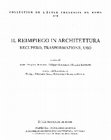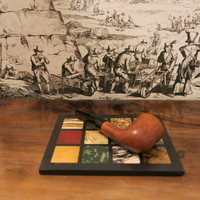Papers by Paola Ciancio Rossetto
Presses universitaires de Caen eBooks, 2022
Bullettino della Commissione Archeologica Comunale di Roma n°96, 1994
Lo stadio di Domiziano : nuovi dati sull'architettura del monumento, 2014
International audienc
Porticus Metelli : riflessioni, 2017
Faire parler et faire taire les statues
La Ciutat En El Mon Roma La Ciudad En El Mundo Romano Xiv Congreso Internacional Tarragona 5 Al 11 9 1993 Actas Vol 2 1994 Isbn 84 88882 09 2 Pags 101 105, 1994

Il Reimpiego in architettura. Recupero, trasformazione, uso, 2008
Paola CIANCIO ROSSETTO, Portico d’Ottavia. Un monumento esemplare per il “recupero” e il “reimpie... more Paola CIANCIO ROSSETTO, Portico d’Ottavia. Un monumento esemplare per il “recupero” e il “reimpiego”.
Il portico d’Ottavia si può ritenere fondamentale per l’analisi del fenomeno del recupero. L’edificio si segnala, infatti, per la sua longevità, articolata in varie fasi in ognuna delle quali si sono sfruttate parte delle strutture precedenti, ma si è innovato inserendo nuove murature ed elementi architettonici spesso di “reimpiego”.
In tal senso, di grande interesse è la costruzione attualmente visibile, databile nel complesso ad epoca Severiana, che, pur riprendendo pianta e modello architettonico augusteo, con l’apporto di varianti e modifiche ha acquisito un aspetto considerevolmente più imponente. L’area del Portico ha una vita intensa anche nel medioevo caratterizzata dalla presenza della chiesa di Sant’Angelo in Pescheria, ricostruita più volte, e del mercato del pesce. Pertanto, le strutture romane sono adattate a svolgere funzioni diverse ed inoltre sono spogliate dei loro materiali in parte riutilizzati in situ, ma anche trasportati altrove per decorare pregiate strutture nuove (duomo di Pisa, loggia rinascimentale delle Benedizioni in Vaticano, S. Maria Maggiore).
The Porticus Octaviae can be considered fundamental for the analysis of the recovery phenomenon. The building is notable, in fact, for its longevity, divided into various phases: every phase was differently characterized, but, always, part of the ancient structure was “reused”.
In this sense, the currently visible building is of great interest, datable mostly to the Severian period, which, while taking up an Augustan architectural plan and model, has acquired a considerably more impressive appearance with the addition of variations and modifications. The Porticus area has an intense life even in the Middle Ages marked by the presence of the church of Sant’Angelo in Pescheria, rebuilt several times, and the fish market. Therefore, the Roman structures are adapted to perform different functions and are also stripped of their materials partly reused in situ, but also transported elsewhere to decorate valuable new structures (cathedral of Pisa, Renaissance loggia of the Blessings in the Vatican, S. Maria Maggiore) .











Uploads
Papers by Paola Ciancio Rossetto
Il portico d’Ottavia si può ritenere fondamentale per l’analisi del fenomeno del recupero. L’edificio si segnala, infatti, per la sua longevità, articolata in varie fasi in ognuna delle quali si sono sfruttate parte delle strutture precedenti, ma si è innovato inserendo nuove murature ed elementi architettonici spesso di “reimpiego”.
In tal senso, di grande interesse è la costruzione attualmente visibile, databile nel complesso ad epoca Severiana, che, pur riprendendo pianta e modello architettonico augusteo, con l’apporto di varianti e modifiche ha acquisito un aspetto considerevolmente più imponente. L’area del Portico ha una vita intensa anche nel medioevo caratterizzata dalla presenza della chiesa di Sant’Angelo in Pescheria, ricostruita più volte, e del mercato del pesce. Pertanto, le strutture romane sono adattate a svolgere funzioni diverse ed inoltre sono spogliate dei loro materiali in parte riutilizzati in situ, ma anche trasportati altrove per decorare pregiate strutture nuove (duomo di Pisa, loggia rinascimentale delle Benedizioni in Vaticano, S. Maria Maggiore).
The Porticus Octaviae can be considered fundamental for the analysis of the recovery phenomenon. The building is notable, in fact, for its longevity, divided into various phases: every phase was differently characterized, but, always, part of the ancient structure was “reused”.
In this sense, the currently visible building is of great interest, datable mostly to the Severian period, which, while taking up an Augustan architectural plan and model, has acquired a considerably more impressive appearance with the addition of variations and modifications. The Porticus area has an intense life even in the Middle Ages marked by the presence of the church of Sant’Angelo in Pescheria, rebuilt several times, and the fish market. Therefore, the Roman structures are adapted to perform different functions and are also stripped of their materials partly reused in situ, but also transported elsewhere to decorate valuable new structures (cathedral of Pisa, Renaissance loggia of the Blessings in the Vatican, S. Maria Maggiore) .
Il portico d’Ottavia si può ritenere fondamentale per l’analisi del fenomeno del recupero. L’edificio si segnala, infatti, per la sua longevità, articolata in varie fasi in ognuna delle quali si sono sfruttate parte delle strutture precedenti, ma si è innovato inserendo nuove murature ed elementi architettonici spesso di “reimpiego”.
In tal senso, di grande interesse è la costruzione attualmente visibile, databile nel complesso ad epoca Severiana, che, pur riprendendo pianta e modello architettonico augusteo, con l’apporto di varianti e modifiche ha acquisito un aspetto considerevolmente più imponente. L’area del Portico ha una vita intensa anche nel medioevo caratterizzata dalla presenza della chiesa di Sant’Angelo in Pescheria, ricostruita più volte, e del mercato del pesce. Pertanto, le strutture romane sono adattate a svolgere funzioni diverse ed inoltre sono spogliate dei loro materiali in parte riutilizzati in situ, ma anche trasportati altrove per decorare pregiate strutture nuove (duomo di Pisa, loggia rinascimentale delle Benedizioni in Vaticano, S. Maria Maggiore).
The Porticus Octaviae can be considered fundamental for the analysis of the recovery phenomenon. The building is notable, in fact, for its longevity, divided into various phases: every phase was differently characterized, but, always, part of the ancient structure was “reused”.
In this sense, the currently visible building is of great interest, datable mostly to the Severian period, which, while taking up an Augustan architectural plan and model, has acquired a considerably more impressive appearance with the addition of variations and modifications. The Porticus area has an intense life even in the Middle Ages marked by the presence of the church of Sant’Angelo in Pescheria, rebuilt several times, and the fish market. Therefore, the Roman structures are adapted to perform different functions and are also stripped of their materials partly reused in situ, but also transported elsewhere to decorate valuable new structures (cathedral of Pisa, Renaissance loggia of the Blessings in the Vatican, S. Maria Maggiore) .